Prosthetic bridges – permanent restorations
Dentysta stomatolog Warszawa Ursynów ADENTIS / Services / Prosthetics / Prosthetic bridges – permanent restorations

A bridge is a permanent prosthetic replacement that replaces one or even a dozen missing teeth. This is a prosthetic solution that cannot be removed – it is permanently cemented in the mouth. Crowns and bridges are the most convenient and comfortable replacements for missing teeth, perfectly imitating natural teeth. Bridges are most often made of porcelain on a metal base, which are characterized by good durability and cosmetic effect. The bridge consists of prosthetic crowns – mounted on abutment teeth adjacent to the missing teeth and a pontic – imitating missing teeth, suspended just above the gum (alveolar ridge). The bridge recreates the function and shape of lost teeth.
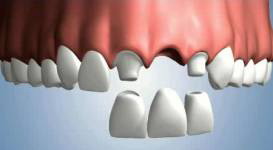 |
 |
In order to build a bridge, the following conditions must be met:
- the abutment teeth must be properly spaced
- Abutment teeth must be well embedded in the bone to withstand the additional load from the teeth hanging above the gum.
Aesthetic replacement of the bridge
 |
 |
 |
 |
 |
 |
A bridge is a very good, comfortable, cosmetic, quickly made and reasonably priced solution, but it requires grinding the teeth.

It’s better to grind your teeth than not replace missing teeth for years, because it leads to serious dental and systemic problems.
Long-term tooth loss leads to major changes in the oral cavity. The teeth adjacent to the gap become tilted and lose bone. There is significant vertical and horizontal bone loss, which prevents immediate implantation. The implantation procedure can be performed only after augmentation, i.e. after bone reconstruction. Sometimes it is a long and expensive procedure. Therefore, missing teeth should be replaced as early as possible. The long-term absence of opposing teeth leads to bone remodeling and tooth migration towards the gap. The teeth tilt towards edentulousness. Each of the above-mentioned things makes prosthetic reconstruction very difficult and sometimes impossible.
The absence of even one tooth causes:
- rotations, i.e. the rotation of the teeth around their own axis, around the gap,
- displacement of teeth in the vicinity of the gap,
- moving of the opposing tooth from the gum,
- Improper chewing habits cause incorrect distribution of forces during chewing, which may lead to loosening of overloaded teeth,
- loss of jaw bones, giving the face a prematurely senile appearance (no teeth also means no roots).
- gum disease and tooth decay caused by the accumulation of food remaining in the places left by missing teeth,
- loss of a beautiful smile.
Long-term tooth loss leads to major changes in the oral cavity. The teeth adjacent to the gap become tilted and lose bone. There is significant vertical and horizontal bone loss, which prevents immediate implantation. The implantation procedure can be performed only after augmentation, i.e. after bone reconstruction. Sometimes it is a long and expensive procedure. Therefore, missing teeth should be replaced as early as possible. The long-term absence of opposing teeth leads to bone remodeling and tooth migration towards the gap. The teeth tilt towards the missing tooth, may rotate around their axis or slide out of the bone. Each of the above mentioned factors makes prosthetic reconstruction very difficult and sometimes impossible.
A bridge on two pillars replacing missing teeth. Prosthetic reconstruction of 4 teeth – 4-point bridge:
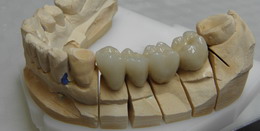 |
|
| Grounded teeth on the model | Porcelain bridge on the model |
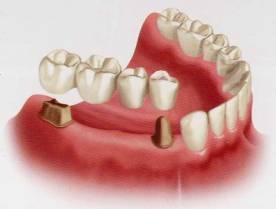 |
 |
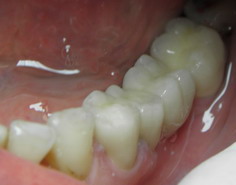 |
| 4-point bridge. | 4-point bridge. |
Prosthetic reconstruction of 3 teeth – 3-point bridge:
 |
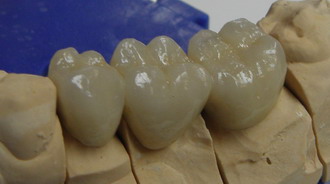 |
| Grinded teeth on the model. | Porcelain bridge on the model. |
Sometimes the so-called single-bank bridges, which are mounted on one pillar, usually in the front section. However, this method is not recommended, especially in the area of lateral teeth, because sooner or later, due to overload, the abutment tooth becomes loose and, as a result, it is lost.
Types of bridges:
- acrylic – as a temporary addition, relatively aesthetic, but not permanent
- adhesive (composite on fiberglass, porcelain) – does not require grinding of abutment teeth, appropriate conditions must be met for attaching this bridge
- metal – made of ordinary or precious metal, they are durable but unsightly.
- metal-porcelain – porcelain bridges on a metal base provide good durability and a very good cosmetic effect, at a reasonable price:
– on ordinary metal – durable and relatively inexpensive – the most popular solution
– on gold – gold has a bacteriostatic effect and does not cause allergies
– for zirconium – perfect cosmetic effect, while maintaining durability, without metal
There is no top one and various possibilities to solve the problem.
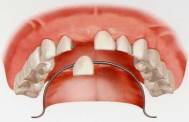 |
 |
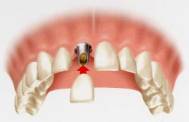 |
| Removable denture | Bridge on two pillars | Implant |
Bridges are prosthetic restorations permanently cemented in the patient’s mouth on abutment teeth, which must be precisely prepared, i.e. ground. This guarantees extraordinary aesthetic effects and ensures 100% functional efficiency. (Full denture provides only 25% of the functions of life). If the patient does not decide to grind the teeth adjacent to the gap, glass fiber bridges can be made. An alternative solution to a bridge and the best, but unfortunately the most expensive, are implants.
Crowns and bridges can not only restore missing teeth, but also mask irregularities such as tilted teeth, etc. Or correct the unsightly shape or color of natural teeth.
Suspending an additional tooth.
Sometimes the patient decides to add an additional tooth. It is then necessary to grind two teeth to suspend one, so that the stabilizing force is greater than the working force.
 |
|
 |
Glass-supported bridges
The biggest advantage of bridges is that they are permanently fixed in the mouth, they do not need to be removed for washing like dentures.
Prosthetic bridges have functionality similar to natural teeth. This is a practical solution and the least burdensome to the patient.
